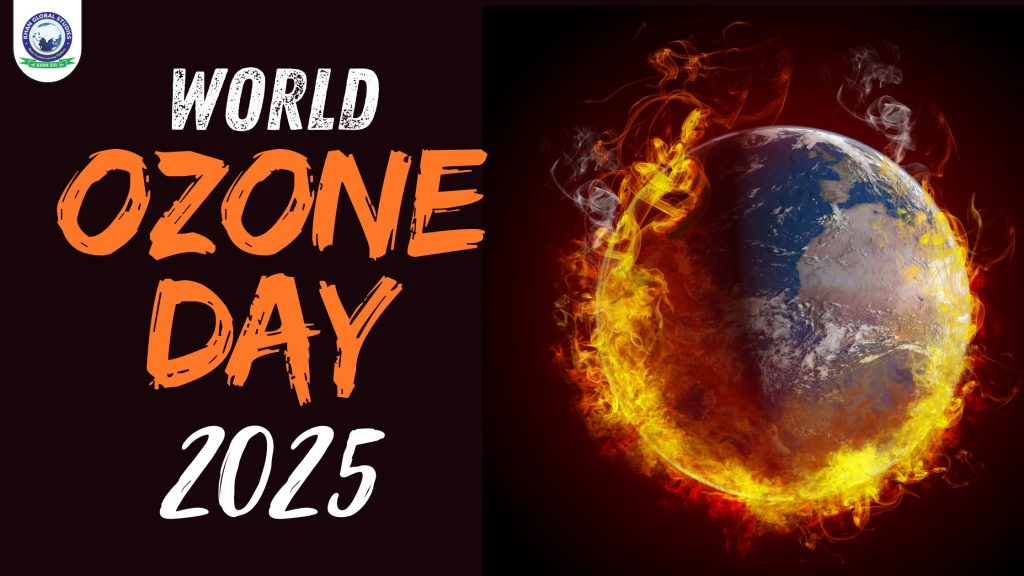World Ozone Day, officially known as the International Day for the Preservation of the Ozone Layer, is celebrated every year on September 16. This date marks a global effort to protect the ozone layer, which acts as Earth’s shield against harmful ultraviolet (UV) radiation from the sun. Without this natural protection, life on earth—including humans, animals, and plants—would be exposed to higher levels of dangerous UV rays, leading to serious health and environmental challenges.
History of World Ozone Day
The history of World Ozone Day is closely linked to scientific discovery and international cooperation. In the early 20th century, scientists discovered that a layer of ozone (O3 molecules) in the atmosphere absorbed much of the sun’s ultraviolet radiation. In the 1970s and 1980s, it was found that human-made chemicals, especially chlorofluorocarbons (CFCs) used in refrigerators and sprays, were causing serious damage to this protective layer. The discovery of the “ozone hole” over Antarctica, especially, raised global alarm.
To tackle this crisis, nations around the world came together to sign the Montreal Protocol on September 16, 1987. This historic agreement aimed to phase out substances that deplete the ozone layer. In 1994, the United Nations General Assembly declared September 16 the International Day for the Preservation of the Ozone Layer in recognition of this achievement.
The success of the Montreal Protocol is often described as one of humanity’s greatest environmental achievements. It set binding targets for reducing ozone-depleting substances (ODS) and has been ratified by every country in the world—making it the first treaty to achieve universal ratification.
Importance of World Ozone Day
World Ozone Day serves as a reminder of the crucial role that the ozone layer plays in sustaining life on Earth:
- The ozone layer absorbs 97-99% of the Sun’s harmful UV-B and UV-C rays.
- Without this layer, humans would face a much higher risk of skin cancer, cataracts, weakened immune systems, and other health problems.
- Plants, animals, and entire ecosystems would suffer, with reduced crop yields and negative impacts on marine and freshwater species.
- Ozone layer protection is not just an environmental issue; it is directly linked to health, agriculture, and sustainable development.
The day also celebrates international unity and scientific progress, showing how nations can come together, guided by research, to solve even the biggest environmental challenges.
Theme of World Ozone Day 2025
Each year, World Ozone Day is celebrated with a special theme. The official theme for 2025 is “From Science to Global Action”. This theme emphasizes the journey from detecting ozone depletion through science, to taking real, coordinated measures across the world to solve the problem and protect future generations. It shows that science must lead to meaningful, united policy and action.
Effect of Ozone Layer Depletion
Ozone layer depletion has many harmful effects, both on health and the environment:
- Human Health Threats: Increased UV radiation on the Earth’s surface leads to more cases of skin cancer and eye diseases like cataracts. People are also more likely to have weakened immune systems when exposed to higher levels of UV rays.
- Environmental Damage: UV radiation harms plants, reduces crop productivity, and damages phytoplankton—the tiny animals that form the base of aquatic food chains.
- Ecosystem Disruption: Excess UV can disrupt complex food webs, impacting marine life, forests, and even urban environments.
- Impact on Materials: Plastics, rubber, wood, and other materials exposed to sunlight without ozone protection degrade more quickly.
- Climate Connection: Many ozone-depleting substances (ODS) are also powerful greenhouse gases. The Montreal Protocol has not only protected the ozone layer but also slowed down global warming by reducing these harmful emissions.
Achievements and Progress
Since the Montreal Protocol was signed, there has been incredible progress:
- Global production of most ODS has been cut by more than 98%.
- The ozone layer is now healing. Scientists expect it to return to 1980 levels by the mid-21st century (between 2050 to 2066).
- The phase-out of ODS has also helped lessen global climate change because ODS are potent greenhouse gases.
- International treaties, like the Vienna Convention and the Kigali Amendment to the Montreal Protocol (which targets hydrofluorocarbons, or HFCs), show that ongoing policy changes and updates are essential for success.
Activities and Celebrations
World Ozone Day is observed every year with:
- Awareness campaigns in schools, colleges, and community centers.
- Educational lectures, exhibitions, and competitions.
- Participation of scientists, teachers, students, policymakers, and the general public.
- Social media campaigns sharing ozone facts, stories, and achievements.
What We Can Do?
Every individual, community, and country has a role to play in protecting the ozone layer:
- Stop or limit the use of products containing ODS (like some old household appliances or chemicals).
- Support and use businesses and technologies that follow the latest environmental standards.
- Advocate and support policies and treaties that protect the environment.
- Stay informed and spread awareness about the importance of ozone layer protection.
Conclusion
World Ozone Day 2025 reminds us that global problems require global solutions, and that science, when joined by international cooperation, can save our planet. The journey from “science to global action” is the heart of this year’s theme: only by working together can we ensure the ozone layer recovers fully, securing a healthier and safer world for all generations to come.




